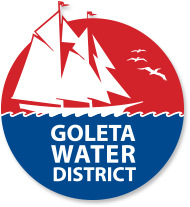
The severe drought continues in the Goleta Valley, and the Stage III Water Shortage Emergency remains in effect. The lack of rainfall over the last several years means that as we enter the summer months, fire season has already begun. Please help conserve water for public health and safety.
For a full list of current drought restrictions, including mandatory outdoor water restrictions, and assigned watering days and times click here.
Frequently Asked Drought Questions
Q: How much rain did we receive this winter, and how has that impacted Lake Cachuma?
A: Goleta received only 61% of average rainfall this winter. After five consecutive below average years, Lake Cachuma has fallen below 15% capacity. Despite the lake being at record lows, levels at Cachuma are predicted to continue to drop over the summer.
Q: Where will water come from to serve customers?
A: The Goleta Valley is fortunate to be able to depend on the Goleta Groundwater Basin. Groundwater stored in the drought buffer will continue to serve as the primary source of supply for customers, with state water, water stored in the lake from previous years, supplemental purchased water and recycled water providing the rest of the supply. While the District can meet projected customer demand, saving water continues to be critical.
Q: Is the District planning to declare a Stage IV drought emergency?
A: Due to availability of groundwater, state water and purchased water the District does not plan to move to more severe restrictions before 2017.
Q: What can I do to save water?
A: Since over half of all water used in the Goleta Valley is attributable to outdoor irrigation, the easiest way to save water is to limit outdoor watering. Prioritize watering drought tolerant plants and trees. If you have a lawn, consider mulching it over and replanting after the drought ends. Rebates for water efficient irrigation equipment are available. Tips, resources and information are provided online here, or by visiting our regional partner www.WaterWiseSB.org.
(Published June 10, 2016)
